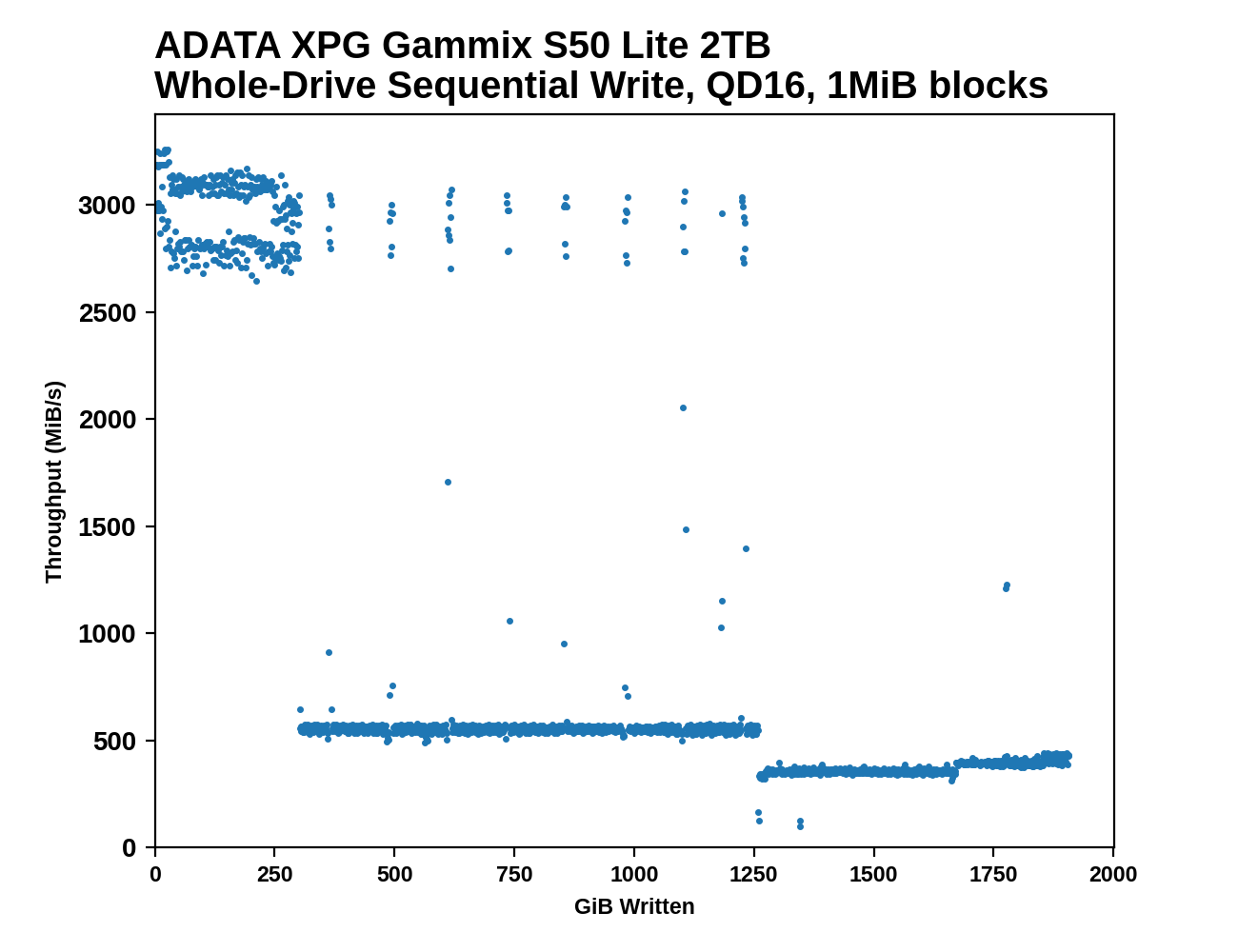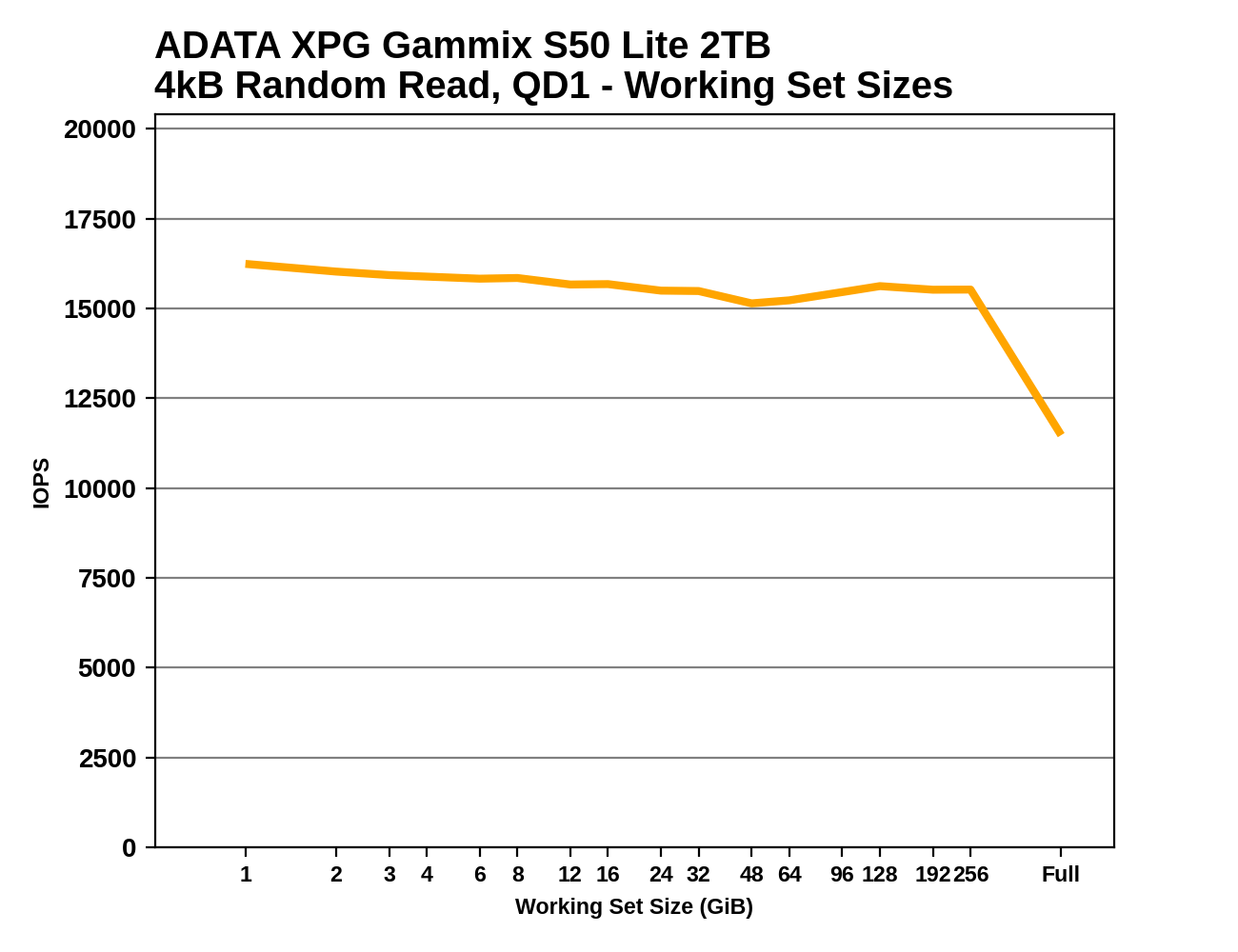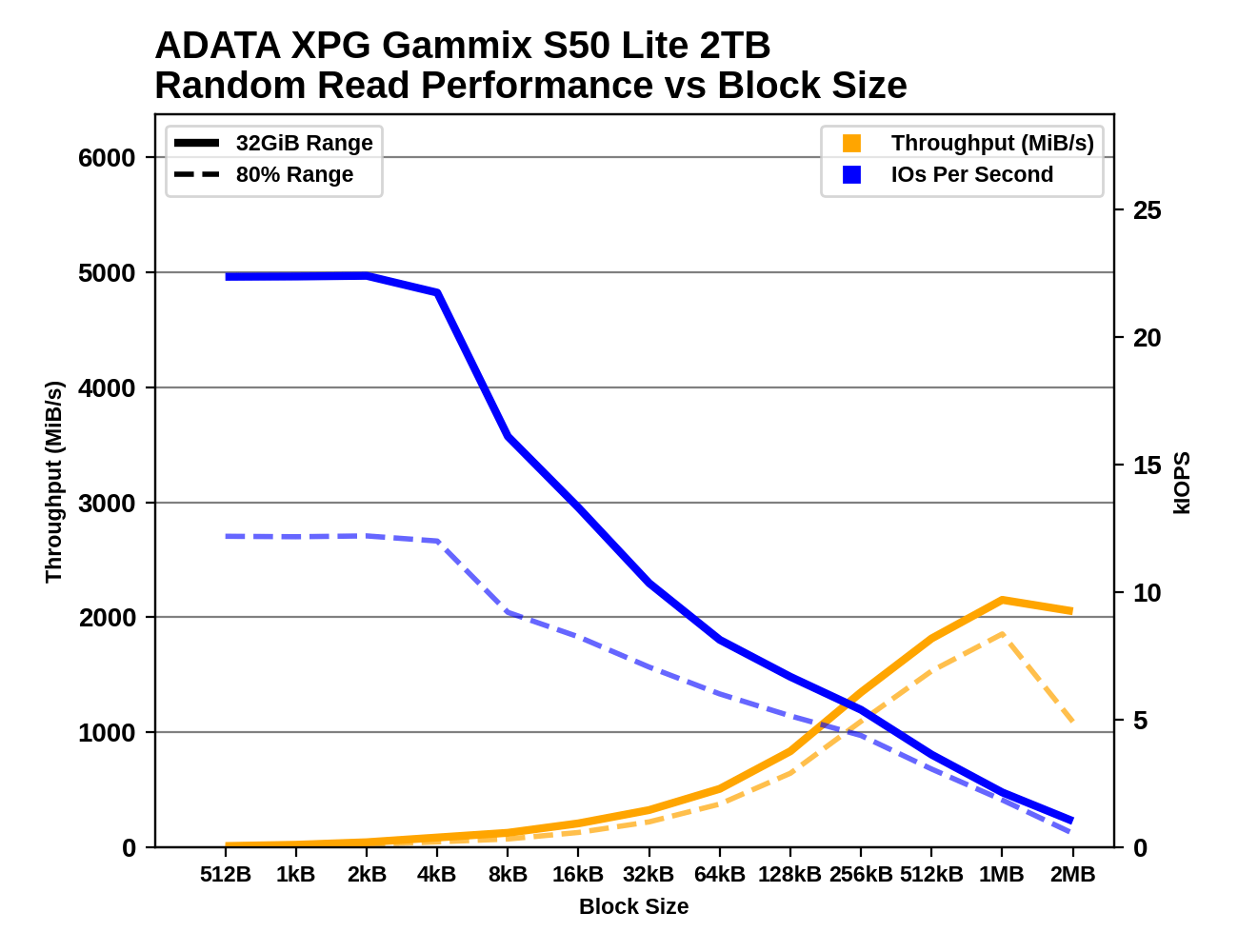The ADATA GAMMIX S50 Lite 2TB SSD Review: Mainstream PCIe Gen4
by Billy Tallis on April 30, 2021 8:00 AM ESTAdvanced Synthetic Tests
Our benchmark suite includes a variety of tests that are less about replicating any real-world IO patterns, and more about exposing the inner workings of a drive with narrowly-focused tests. Many of these tests will show exaggerated differences between drives, and for the most part that should not be taken as a sign that one drive will be drastically faster for real-world usage. These tests are about satisfying curiosity, and are not good measures of overall drive performance. For more details, please see the overview of our 2021 Consumer SSD Benchmark Suite.
Whole-Drive Fill
 |
|||||||||
| Pass 1 | |||||||||
| Pass 2 | |||||||||
The ADATA XPG Gammix S50 Lite shows an almost QLC-like performance drop when the SLC cache runs out after about 300GB: it falls down to SATA speeds. But even though its post-cache write speed is half of what we're used to seeing from TLC drives (most of which use controllers with 8 channels rather than 4), the S50 Lite still has a big lead over the two QLC drives in this bunch.
On the second pass of filling the drive, the S50 Lite's SLC cache is good for only about 14GB and the post-cache performance is much less consistent, with frequent drops below 100MB/s and spikes back up to SLC speeds around 3GB/s.
 |
|||||||||
| Average Throughput for last 16 GB | Overall Average Throughput | ||||||||
Working Set Size
 |
|||||||||
The S50 Lite has excellent random read latency for smaller working sets, beating all but two of the drives in this bunch. But the consequences of having only 1GB of DRAM for a 2TB drive show up at the end of the test, where the random read performance falls off sharply once the reads span the entire drive rather than just a small slice.
Performance vs Block Size
 |
|||||||||
| Random Read | |||||||||
| Random Write | |||||||||
| Sequential Read | |||||||||
| Sequential Write | |||||||||
The S50 Lite offers the same random read IOPS for all the IO block sizes from 512 bytes up to 4kB, but when testing random writes there's a clear preference for 4kB block sizes rather than anything smaller. Rather surprisingly, sequential reads with 4kB block sizes are far slower than for slightly smaller or larger block sizes; it would appear that the drive assumes 4kB reads will be random IO, and skips whatever caching or prefetching is active when using other block sizes.










93 Comments
View All Comments
Tomatotech - Friday, April 30, 2021 - link
Which is better, TLC or SLC?SLC of course!
Any decent QLC drive will operate in SLC mode for as long as it can (e.g an empty 4TB QLC drive has 1TB of SLC space, and a half-full 4TB QLC drive will have around 500GB of TLC space). So you can rest easy, they’re even better than your precious TLC drives.
FunBunny2 - Friday, April 30, 2021 - link
"QLC drive will operate in SLC mode"many times the 'experts' here at AT have asserted that 'SLC mode' by xLC NAND just ain't like 'real' SLC. don't recall how large the falloff is, but it exists.
sonny73n - Saturday, May 1, 2021 - link
"Any decent QLC drive will operate in SLC mode for as long as it can (e.g an empty 4TB QLC drive has 1TB of SLC space,"How many QLC drive can operate in SLC mode? But hey, I'm paying for 4TB, I expect to have a full 4TB of reasonable quality NAND, not 4TB of crappy NAND and hoping it would work well if I use only 1/4 of its capacity.
sonny73n - Saturday, May 1, 2021 - link
"So you can rest easy, they’re even better than your precious TLC drives."Stop spreading misinformation! Internet have enough fake news already.
TheinsanegamerN - Monday, May 3, 2021 - link
"So you can rest easy, they’re even better than your precious TLC drives"Imagine thinking the above line justifies your technology being "good". You can take your condescending attitude and shove it. Nobody buys a drive to use a quarter of its capacity just to try to keep speeds up to previous generation tech just to pay as much as said previous gen tech. Unless QLC brings 2TB NVMe drives under $100 it's worthless to most consumers.
Linustechtips12#6900xt - Monday, May 3, 2021 - link
let's just admit that nand is nand and it's honestly pretty great, do we need something new yes, was that intel 3d x-point, possibly but according to them no, so we are gonna have to deal with cheaper higher capacity SSD's for a while as long as I can still get an SLC/MLC/TLC SSD for my boot drive I don't care about having my games on qlc or whatever comes after and as long as OEM for laptops dont use qlc or later for boot drives im fine with it.FunBunny2 - Monday, May 3, 2021 - link
"as long as OEM for laptops dont use qlc or later for boot drives im fine with it."whose going to stop them from putting QLC or whatever the next xLC is called in your laptop? the FTC? not even Biden's cabal has the stones to do that.
Linustechtips12#6900xt - Wednesday, May 5, 2021 - link
yeah I agree, not that any president would care about nand but anyway if it does happen which it will, I know i can probably buy a 120gb model and just buy a tlc or lower drive either way and flip the 120gb or something maybe put it into an HPC machine something like that.Linustechtips12#6900xt - Wednesday, May 5, 2021 - link
HTPC*eastcoast_pete - Friday, April 30, 2021 - link
So, do I get this correctly? Basically a waste of perfectly good PCIe4 channels? I guess if you have plenty, not so bad, but otherwise, not really.